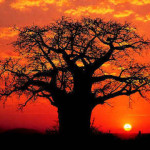History of the Baobab Tree

Did you know that the Baobab tree is known as “The Tree of Life,” and the “Upside-down tree?” A native of Africa, Australia, and Madagascar, the trunk of the Baobab tree can grow in diameter of 60 feet. The trunk can be used for shelter, prison, burial place, and a water reservoir, which can hold up to 4500 liters of water. Its’ branches can grow up to 75 feet tall and its’ leaves can grow to 5 inches long with three to seven leaflets. The Baobab tree has many practical uses such as medicinal, the making of rubber, jewelry, clothing, fishnets, and others.
Fibers from the bark can be turned to rope. The leaves from the baobab tree are eaten to boost the immune system. The fruit from the baobab tree has three times more vitamin C as an orange; fifty percent more calcium than spinach; and an abundant source of anti-oxidants which help with reducing the risk of disease such as cancer and heart disease. In Africa, the Baobab tree is often used as a community meeting place where members share, exchange information, and interact with each other.
Inspirational Minds
“One’s work may be finished someday, but one’s education never”
Alexander Dumas
“Children have never been very good at listening to their elders, but they have never failed to imitate them”
James Baldwin
“When a man lives a decent life, takes care of his family, and is a contributing member of his community, that’s not news. Such a man doesn’t get into the headlines”
Milt Hinton
“We ourselves have to lift the level of our community, the standard of our community to a higher level, make our own society beautiful so that we will be satisfied. We’ve got to change our minds about each other”
Malcolm X
